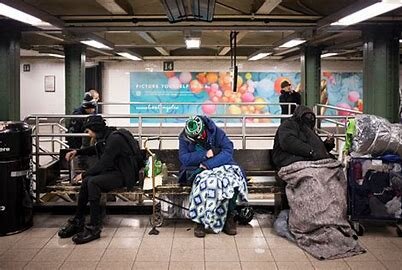$30,000 subsidy per subway rider? OMG – we're all gonna die . . .
Poll - Total Votes: 4
set subway fare higher to cover repairs and maintainance
every couple of decades, have a $25 billion bailout crisis
You can only vote on one answer.

Photo above - are these guys included in the official headcount of subway riders? Or do they live here? Wait - it can be two things at once, can't it?
If you needed any more proof that government bureaucrats and politicians are too inept to do ANYTHING, check out the link at bottom. Boston's says it needs $25 BILLION (with a B) to maintain and repair its mass transit system.
This is such an astonishing number, I immediately googled “How many daily riders does the MBTA have?” The answer seems large enough – 760,000. Until you divide it into the $25 Billion which the transit bureaucracy is demanding. It works out to $33,000 PER RIDER !!! Of course, Boston won't need $25 billion EVERY year - just until the next time repairs and maintenance get out of hand.
You can probably predict what my next Google query was. “What top rated cars can I buy for $30,000?” How about Motor Trend's 2024 “Car of the Year” - the all-new Toyota Prius? It gets 57 miles per gallon. You can't make up stuff this bizarre - in our version of all the infinite universes it costs more to put a guy on the subway than to give him a brand-new car for free. I also tried to find out how many gallons of fuel per passenger mile Boston's MBTA uses. Good luck with that - if you can find a source, let us know. So let's stick to the known facts . . .
- Boston's subways and light rail run on electricity, which is mostly generated from aging coal fired plants
- The subways operate at less than half capacity – sometimes less than 10% of capacity - during much of the day.
- A subway car weighs 40 tons. And it's usually closer to empty than full. And you need thousands of them to move the 760,000 passengers. If each car was occupied to capacity (100 riders), for a 2-way commute, you'd need more than 4,000 subway cars. (Check my math please)
The real story though - the one not explored in the CBS report - is “how did Boston get $25 billion behind in it's subway maintenance?”
The answer may sound like a snark, but it's not: When public infrastructure is involved, there is rarely enough money budgeted for repairs and maintenance. It's not just Boston I'm condemning here. It's almost every city or state government. Bureaucracies have 2 choices –
1 - Set daily fares (or KWH electric rates) high enough to cover the actual cost of maintaining competent service, or . . .
2 - Keep rates lower, and let things go to the point of failure . . . THEN plead for a bailout.
Since the bailout will ALWAYS be needed far in the future the guys who pick door number 2 are always off the hook. The new guys – 20 years later – inherit the billion dollar repair problems. “Our subways are a dangerous monstrosity” . . . “Another million acres of California brushland burned because we have century old high-tension wires” . . .“The city of Lahaina is destroyed. It burned to a crisp in less than an hour – both the electric wires AND the water system were grossly deficient.” . . .
$30,000 per rider! Okay . . . I'll give that a break. California and Hawaii pay the highest electric rates in the nation. The HIGHEST! In many cases DOUBLE what it costs people living in normal places. How much more would electricity in paradise cost if electric grids dating back to the Woodrow Wilson administration had been properly maintained and modernized? No wonder there are crazy high incentives to install rooftop solar. If we depend on the grid, we're doomed.
I live in Florida, but I'm not going to gloat here. Shitty mass transit is a feature (not a bug) of urban life. Even Washington DC, which built the most modern subway system in the world a few decades ago, is now castigated for spending zero to keep it nice. DC metro apparently has the highest rate of breakdowns in the USA – worse than Boston and NY. Where I live (near Tampa, Florida) we don't actually have subways. Something about not being able to dig more 3 feet down without striking an underground river. So, while Floridians are spared the ongoing nightmare of public transit run by morons and shyster politicians (who are more concerned with banning library books) we have our own problem: Fresh water - not enough of it. Florida's ground water is all pumped out. Seawater is infiltrating in, making it undrinkable. This is due to massive population growth, failing infrastructure, and an unwillingness to charge what it costs to purchase desalinization plants and reservoirs. Florida is the state that couldn't even snuff out a few hundred invasive Burmese pythons - and now we have 100,000. Why should anyone expect that safe drinking water could be handled competently?
I'm just sayin' . . .
MBTA says it needs $24.5 billion to repair transit system - CBS Boston (cbsnews.com)




